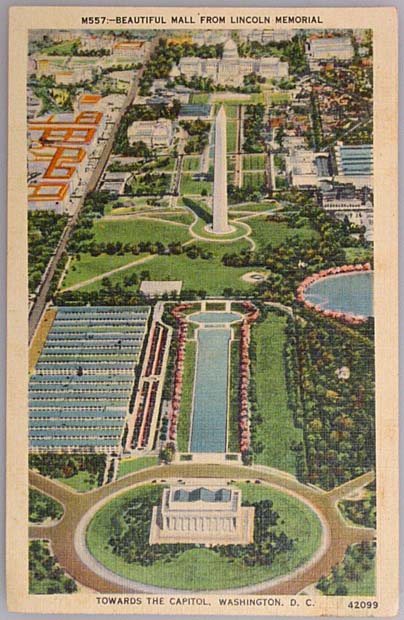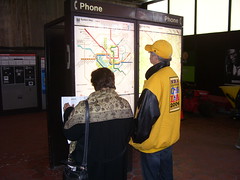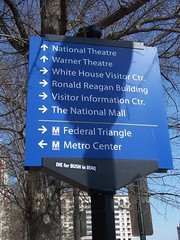National Mall "stuff"

1. There are a bunch of books on the subject. I am thinking that should use this fact as the impetus to finally get a "DC/urban issues" reading group going:
-- The National Mall: Rethinking Washington's Monumental Core
-- The Washington National Mall
-- Worthy of the Nation: Washington, DC, from L'Enfant to the National Capital Planning Commission
-- (journal article) "Politics, Public Space, and Memorials: The Brawl on the Mall"
Plus National Capital Planning Commission reports, plus even some journal articles and such about museums such as these:
-- Grasping the World: The Idea of the Museum;
-- Continuing dialogues: Evolving views of the National Museum of the American Indian (journal article);
-- The National Museum of the American Indian as Cultural Sovereignty (journal article).
2. The American Society of Landscape Architects has released today "recommendations of a panel of design experts who convened to address plans to revive the National Mall. The panel's findings report is in response the National Park Service’s recently published preliminary preferred alternative and addresses specific features of the Mall including: additional memorials, water features, Union Square and the downtrodden grass and walkways.
A full copy of the findings report as well as the executive summary and video clip of the panelists’ working session can be found on ASLA ’s Web site (www.asla.org/nationalmall).

(Photo source unknown.)
3. I find one of the panel's recommendations:
-- The panel calls for an end to additional centers of interpretation for monuments and memorials. They propose centralizing these needs in a National Mall orientation center. Renovation and remediation of the Smithsonian Arts and Industries Building , now empty yet near a key Metro stop, could serve this purpose.
to be particularly intriguing although I can't imagine special interests not being able to get to Congress, and get "special exceptions" for their "unique" circumstances. And it would require working with the Smithsonian Institution, which has their own problems.
4. But then again, one of the big problems is that the Mall is under the purview of the National Park Service and the buildings bracketing the Mall are for the most part under the purview of the Smithsonian (plus the National Gallery of course, and the Architect of the Capitol) and I don't know how much these institutions interact.
5. The aforementioned National Park Service’s recently published preliminary preferred alternative is online here. It was released a couple weeks ago.

6. Plus, the National Park Service is implementing a wayfinding system according to the Washington Post, "Here, Even Icons Need IDs: Park Service Wants Tourist-Friendly Signs for Mall Monuments," and you see evidence of this in markers starting to be installed in parks such as Logan Circle (I don't have photos yet).
But this in part is the impetus for my future post on wayfinding. There are at least 10 separate wayfinding "systems" in the city. They aren't coordinated. We need a wayfinding conference as a start, and then a concordat to start integrating signage into one wayfinding system within the city. (And it's time to assess and update the "blue" wayfinding signage program. Plus, how many years should it take to get the Children's Museum taken off signs since it hasn't existed in the H Street neighborhood for at least four years.)
The wayfinding systems (not in ranked order necessarily):
1. The street and highway signage system generally (DDOT);
2. The "blue" wayfinding signage system (DDOT pays for it, the Downtown BID coordinates the system under contract);
3. The heritage trail signage (CulturalTourismDC);
4. The National Park Service;
5. The Architect of the Capitol;
6. Signage information on bus shelters and signs and in subway stations;
7. DC Department of Parks and Recreation for city parks (not really, but they should);
8. Intra-campus signage systems such as for the Library of Congress or Catholic University;
9. Banner programs within Business Improvement Districts and commercial districts, and neighborhoods;
10. While it doesn't exist in a coordinated fashion, a parking wayfinding signage system ought to exist as well (within the context of mobility, not just automobility).

Labels: National Mall, urban design/placemaking, wayfinding



2 Comments:
Very well composed and presented.
Thank you so much for sharing.
if you are searching for the Tax Professionals in San Antonio then your destination ends at Uhlenbrock CPA. We are the best when it come to tax preparation just call us at (210) 701-1040 and book your appointment with expert.
Post a Comment
<< Home